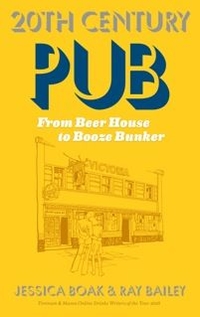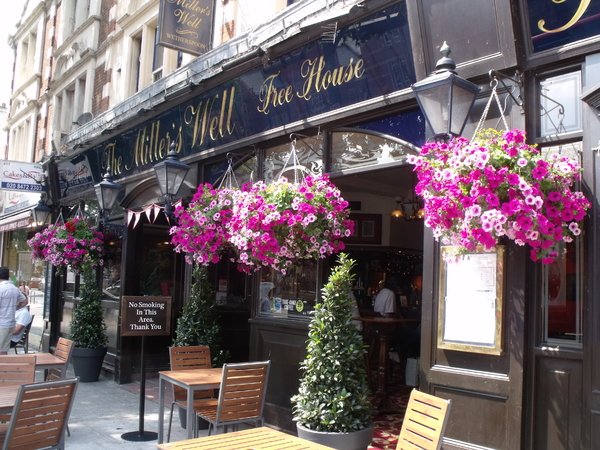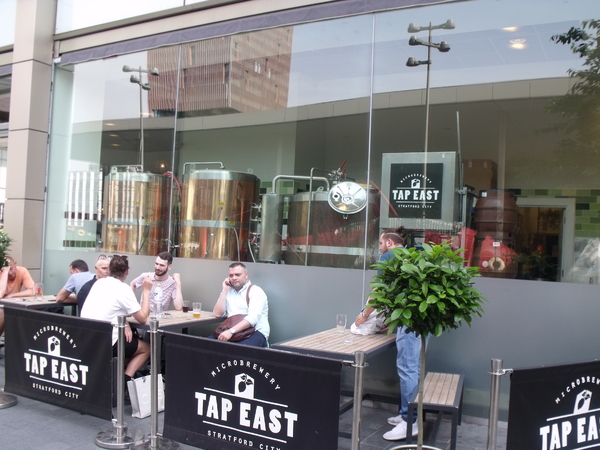Don't call Last Orders on embattled pubs
Added: Saturday, August 19th 2017

20th Century Pub, Jessica Boak and Ray Bailey (The Homewood Press, £16.99)
We speak of “the British Pub” in hushed and reverential tones. The very expression suggests there is one standard model, a Rose & Crown for every town and village, with a beaming landlord, a warm welcome and a pint of the foaming best.
But pubs come in all shapes and sizes, tuppence coloured and penny plain. There are some we would hurry back to, others we would avoid like the plague.
And the pub is not immutable. What we call the local or the boozer today is vastly different to pubs a hundred years or so ago. The fact is underscored in this wonderfully entertaining and informative book by Boak and Bailey. They have brought their renowned forensic research and eye for detail to bear on the pub as an institution, showing – often amusingly – just how much the pub has changed in modern times.
It has survived two world wars but now it’s under greater threat than the best efforts of the Luftwaffe. It once stood proud on every street and highway and byway but it’s closing in record numbers.
The authors suggest that those on the left of politics would blame capitalism for the decline of the pub. That clearly is an over-simplification. The pub has always been a reflection of society and today finds it difficult to compete with the rise of all the new attractions the high street has to offer.
When I walked down St Peter’s Street, the main drag in St Albans, people were sitting in enclosed areas on the pavement, sipping their lattes and cappuccinos served by not one but two coffee shops that stand cheek by jowl in what used to be Woolworth’s.
A few yards away, the large BHS store stands forlorn and empty and will no doubt be transformed into further purveyors of frothy and absurdly expensive caffeine.
It was once very different. My parents, before they married, lived on the same street in Bermondsey, south-east London. It was a short street but it had a pub at either end. There was a powerful reason for that. As Boak & Bailey show, the pub was one of the mainstays of working-class life for most of the 20th century. With the music hall in decline due to the rise of the cinema, the pub offered warmth and cheer for millions of people – mainly men, it must be admitted – who enjoyed a few pints with their mates and who lived in houses short on such creature comforts as heating and indoor toilets.
Indoor toilets, though, could be rudimentary in some pubs in the 19th and early 20th centuries. I recall reading a description of tenement pubs in Liverpool which were not just spit and sawdust but had troughs in front of the bars where male customers could urinate while drinking. This explains why I have never been keen on the northern habit of recycling spilt beer.
As Boak and Bailey show in graphic detail, many pubs in the early 20th century were downright awful. You would not have wanted to drink in them unless you stopped at the local pharmacy en route for an inoculation against cholera.
The pub moved on from such horrors. But it faced a 20th-century horror of a different kind: the belief of politicians, social reformers and brewers that they knew best what sort of establishment their customers should drink in. It was a snob-ridden attitude in keeping with the belief that if you gave the working class baths they would only store coal in them.
Boak & Bailey describe at length a piece of social engineering during World War One that was driven by that bumptious little pipsqueak, David Lloyd George. He was a teetotaller who made a grotesque speech as Minister of Munitions in which he claimed that drink was doing more damage to the war effort than the German bombs raining down on British cities.
The result was the Defence of the Realm Act that curtailed pub opening hours followed by the State Management Scheme that saw pubs and breweries in three areas – Enfield in London, Gretna in Scotland and, most famously, Carlisle – nationalised.
The areas were chosen as they had major munitions factories. It was claimed by Lloyd George that workers in the factories would descend on local pubs and drink themselves into a stupor and, as a result, were incapable of turning out shells and bullets. As is the case today, many of these claims were wildly overblown and sensationalised. And there is no evidence to show that opening pubs for just a few hours a day reduced the consumption of alcohol – though it must have been hard to get legless on the heavily watered down beer on offer. It was nicknamed “Lloyd George Beer”, much to the annoyance of the Welsh demagogue.
The Carlisle pubs were designed by a radical architect called Harry Redfern who was a devotee of the Victorian Arts & Crafts movement. His pubs were spacious and they encouraged sitting rather than vertical drinking, with food served by uniformed waitresses. In order to combat over-consumption, “treating” or buying rounds was banned.

Following the war, with opening hours still restricted, brewers, learning from the State Management Scheme, designed what they called Improved Pubs. Here was another glaring example of middle-class snobbery: if you offer improved pubs, the behaviour of the hoi-polloi using them might also improve.
Improved pubs were enormous and divided into several rooms. Boak and Bailey helpfully provide a plan of one of these establishments with rooms designated Weekend, Men 2nd Class, Mixed 2nd Class and Women 2nd Class. Well, at least women were being allowed in, even if their morals were dubious. I wonder what went on at weekends?
Naturally, in the finest English tradition, the gentry who built improved pubs didn’t drink in them. They had their own rather special outlets known as roadhouses, the 20th century equivalent of the coaching inn. One has survived, just round the corner from my house. It’s called the King William IV and in my time in St Albans it has weaved between being a Beefeater steak house, a Scottish & Newcastle pub, a Thai restaurant – a spectacular failure – and now a Mitchells & Butlers Ember Inn.
But it was originally built and owned by Phipps of Northampton. Why would a brewery in the Midlands open a large pub in Hertfordshire? Simple. Between the two world wars, only the better-off could afford cars. The roads were uncluttered and Cynthia and Cecil motoring down to London for the weekend could stop in St Albans, conveniently situated on Watling Street and handy for the Great North Road, for a snifter and a spot of luncheon.
The “King Will”, as it’s known, is capacius but some roadhouses were bigger and even – Boak and Bailey report -- sported swimming pools.
Many pubs were destroyed by bombing during World War Two. Those that survived unscathed found themselves and their owning breweries under attack by government again. There were calls from the Labour Party for the post-war Attlee government to nationalise the brewing industry but this was ignored due to the costs involved.
But planners and politicians were busy trying to limit the total number of pubs and to allow new ones to be built in the post-war New Towns on a restricted basis. The brewers cannily responded by building what were dubbed Modern Pubs, vast and sprawling, designed to pack in as many customers as possible.
Not all customers were impressed and they bemoaned the trend towards these faceless emporia. But until the rise and influence of CAMRA in the 1970s, the customer was no longer king. The brewers called the shots – increasingly so, with a rush of mergers and takeovers that created the “Big Six” national brewers who owned more than half the nation’s pubs and stuffed them with new-fangled keg beer and lager.
Modern pubs morphed into theme pubs. Boak and Bailey have great fun describing some of these monstrosities that included pubs shaped like pineapples and other exotic fruit and – to prove their extra-terrestrial credentials – space ships. I seem to recall, I think in Dunstable, one designed like a Sputnik – a step too far for Yuri Gagarin, I suspect.

As a throwback to the roadhouses of the inter-war years, some of these theme pubs even had fountains, in tune with the frothy keg beers such as Watney’s Red Barrel that befouled the times. John Young, the ebullient and much-missed chairman of Young’s of Wandsworth, was so affronted by these architectural carbuncles that he entered one and poured a packet of soap flakes in to the offending fountain. He may, single-handedly, have put an end to this nonsense.
Then along came the gastro-pub. I think I may have said at some stage – and Boak and Bailey will no doubt dig out the quote – that the problem was that they rapidly became all gastro and no pub. The first of the breed was the much-hyped Eagle on Farringdon Road in London. I was unimpressed by a short and uninspired beer list and, while I’m no foodie, was underwhelmed by the scoff.
Food of a different kind appeared with the arrival of Tim Martin’s Wetherspoon chain, discussed at length by the authors (pictured above, Wetherspoon's Miller's Well in East Ham, East London). While gastro-pubs waxed and quickly waned, Wetherspoon has become a permanent and immensely popular fixture on the modern pub scene. Beer and food are cheap and cheerful and while some decry the sheer size of most of the outlets – in former cinemas and banks – they pack in the punters.
In a sense Wetherspoon has returned the pub to its early 20th-century roots, making pub-going an affordable night out for people on lower incomes who prefer to pour salad cream over their green stuff rather than drizzle it with oak-aged olive oil.
In sharp contradiction to the vast and voluptuous average Wetherspoon is the latest phenomenon, the micro-pub (see Tap East, Stratford, East London above). Boak & Bailey interviewed the somewhat dyspeptic founder of the pop-up pub, Martyn Hillier, who has to have yet another lengthy grumble about CAMRA’s alleged lack of support. He conveniently fails to mention that the campaign named him Campaigner of the Year in 2015 or that I have devoted considerable space to his movement in the Good Beer Guide.
I am more charitable than Hillier and welcome these often delightful, simple little ale houses in empty shops or under railway arches. They are a throwback not so much to the early 20th century but to the Tom and Jerry houses of the mid-19th.
Boak and Bailey prove that, despite all the best efforts of its enemies and detractors, pubcos and supermarkets, the good old British boozer is hard to kill off. We may have fewer today but it’s not going away.
This is a scintillating read, well-informed, well-argued, painstakingly researched, illuminating and inspiring.








